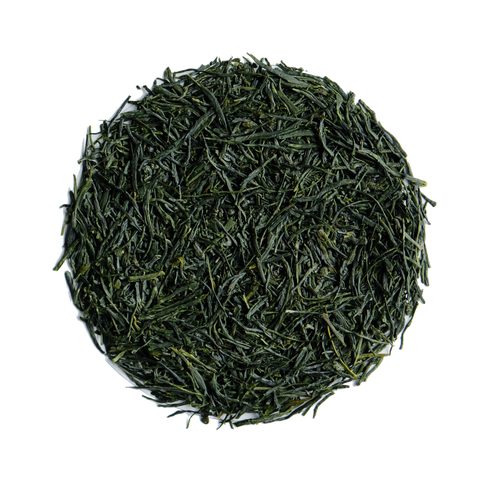GREEN TEA (SENCHA)
Please refer here for general brewing guidelines.
Our sencha green teas are produced entirely from first-flush spring leaves. Harvested only once a year, these teas represent the pinnacle of our productions, and a standard of what is possible with organic farming in Japan.
ASA-MUSHI (LIGHT-STEAMED)
Premium Midori 初摘みみどり

The best of Japanese sencha green teas, this is made from Hashiri Shincha (走り新茶), the very first buds of spring.
Prepared since the previous fall, the first buds of spring are packed with nutrients stocked up in the roots over the long, cold winter. The result is the highest grade of tea leaf and an especially strong and complex flavor. Harvested from our best fields at the start of the shincha (first flush) season, the theanine amino acid content of the buds is at its peak, imparting in the tea a deep, sweet and savory flavor reminiscent of a light sea breeze.
- Brewing guidelines: 2 piled tsp. to 100-300 ml boiled water cooled to 50˚C/122˚F, steeped for 2 minutes.
- Harvest: April, First Flush
_______________
Spring Midori 春の香みどり

The 88th night (八十八夜, Hachijuhachiya) from the first official day of spring, Risshun (立春), marks the traditional beginning of the shincha (first flush) picking season. Tea leaves picked in the two to three weeks following this day are the most highly prized in Japan.
Our Spring Midori offers a highly aromatic presence and powerful but elegant and well-rounded, lingering sweetness. A much appreciated and excellent choice of gift, as well as for savoring at home.
- Brewing guidelines: 2 piled tsp. to 100-300 ml boiled water that has been cooled to 50˚C/122˚F and steeped for 2 to 3 minutes.
- Harvest: May, First Flush
_______________
Premium Kabuse 冠茶

Shaded for 20 days before harvest, rather than the usual two weeks, the deep pine-green leaf needles delight with a rich ambrosia of umami savoriness. Distinct and delightfully complex, but harmonious vegetal notes make it all at once refreshing, nourishing and stimulating.
-
Brewing guidelines: 2 piled tsp. to 100-300 ml boiled water cooled to 50˚C/122˚F, steeped for 2 minutes. Increase temperature to 70˚C/158˚F to 90˚C/194˚F for the second brew.
- Harvest: May, First Flush
_______________
Other Cultivars

While the overwhelming majority of our tea is made from the Yabukita cultivar, there are many other varietals grown in Japan. Those produced by us include Yamakai (mineral, with a distinct taste of wild blackberries, and a strong umami undercurrent), Sayama-kaori (fruity in flavor, but with a floral aroma and aftertaste), and Kurasawa (vigorous in its initial astringency which shifts quickly to a gentle umami and sweetness reminiscent of sweet potato).
These are each produced in very limited quantities each year, so special care is taken with their preparation to ensure that each tea showcases the unique virtues of the type of tree from which it was harvested. We recommend trying these side-by-side with our Yabukita asa-mushi teas to best appreciate the impact of cultivar-type on teas that are otherwise produced by the same standards.
CHU-MUSHI (MIDDLE-STEAMED)
Yabukita Midori やぶきたみどり

The Yabukita cultivar's flavor and aroma make it very suitable for Japanese sencha. The first flush of young leaves undergoes the steaming, drying and rolling process, but not the finishing process of separating the leaves from stems as done with the Premium and Spring Midori First Flush teas.
This medium-steamed green tea (chumushi-cha) brews a light golden-green cup with a sweet aroma of freshly cut grass. Its refreshing, clean flavor and mild, pleasing astringency on the palate makes it an excellent accompaniment to light meals. A reliable choice for the occasional or daily sencha drinker.
- Brewing guidelines: 2 piled tsp. to 100-300ml water at 60℃/140 ºF steeped for 1-2 minutes
- Harvest: May, First Flush
_______________
Setoya Midori 瀨戸谷みどり

This is an easy-to-drink and full-bodied sencha that tastes of nature, balancing sweetness and shibumi (astringency). We believe this does well in capturing the characteristic flavors of Setoya, an area in Fujieda city, Shizuoka Prefecture, where many of our fields are located.
- Brewing guidelines: 2 piled tsp. to 100-300 ml boiled water cooled to about 60-70˚C/140-158˚F steeped for 1-2 minutes.
- Harvest: May, First Flush
FUKA-MUSHI (DEEP-STEAMED)
Deep-Steam 山の深蒸し茶

In the later portion of the spring harvest season the leaves begin to grow thicker. This means that they must be steamed longer to become soft enough for us to process. The longer steaming, however, also means that the young buds at the very tips become so soft that they break into small fragments and powder. The result is a mix of larger leaves and powdered buds, which impart a deeper color and opacity to the soup. This kind of tea brews up stronger and faster than light- or middle-steamed teas, and has become popular for its versatility, bright color, and strong flavor.
-
Brewing guidelines: 2 piled tsp. to 100-300 ml water at 80℃/180ºF, steeped for 45 seconds
- Harvest: April to May, First Flush
_______________
Aged Midori 深みどり

It is said that Tokugawa Ieyasu, the founder of the Tokugawa clan of shoguns, was fond of aging shincha harvested in May in a container. Such Kuradashi (“removing from the warehouse”) generally refers to tea that has been aged for at least one year.
The characteristic grassy and vegetal qualities of our shincha is taken over in our Fuka-midori (“deep green”) aged tea by a bolder balance of astringency and umami, and is therefore recommended for sencha drinkers fond of strong green teas.
-
Brewing guidelines: 2 piled tsp. to 100-300 ml water at 80℃/180ºF, steeped for 1 minute
- Harvest: May, First Flush of previous year
